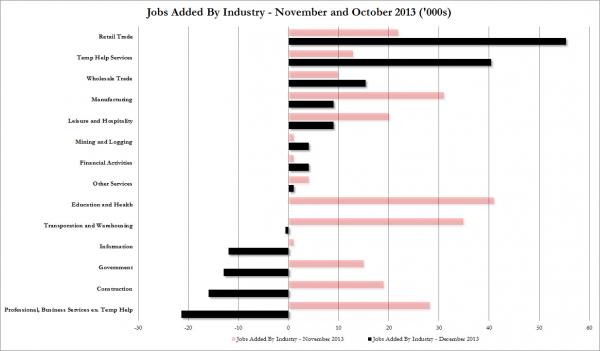As we reported earlier (and have been for the past three years), there is a reason why the media prefers not to talk about the quality aspect of US job gains, and instead focuses on the seasonally adjusted quantity: there simply is no “quality.” Take today for example, when we learned that more than half of the 74K jobs gained in the month of December were temp jobs (which mysteriously were not affected by the weather: only the high paying ones somehow got crushed by snow in December), and when adding the lowest paying retail and wholesale trade jobs, one got nearly 50% more than all the job gains for the past month.

Perhaps the only good news in today’s job report is that it is now in the past, because absent from some inexplicably respected so-called pundits doing the most idiotic thing imaginable, and saying to just ignore this report, there was absolutely nothing good one could say about the lowest monthly job gain since January 2011 (driven by temp and retail workers) at least until it is revised several times over the next 3 years when we ultimately learn that today’s noisy jobs print was really a gain of 500K jobs. Of course by then, there will be far bigger problem to deal with.
However, while December in the past, the future still remains. And it is here that we have some good and bad news. According to the just released Occupation Outlook Quarterly (OOQ) looking at the period from 2012 to 2022 released by the BLS, in the future the US will be in a significant need of jobs, which is good for all those worried that the economy is grinding to a halt, or those demoralized from not having a job for months on end and unsure if this will ever change.
That’s the good news.
The bad news is that as in the case of today, the vast majority of future jobs will pay absolutely miserable salaries.
The chart below shows what we are talking about: it lays out the job categories for the 20 occupations with with the highest projected numeric change in employment. Alas, of the Top 10 highest growing jobs, 9 out of 10 will pay less than $35,000 a year.

